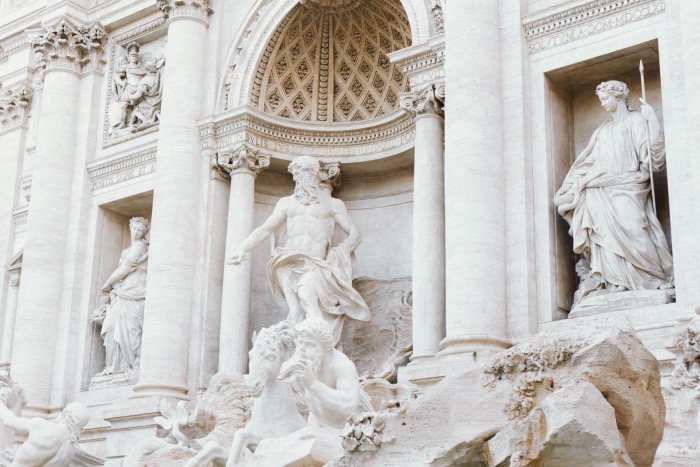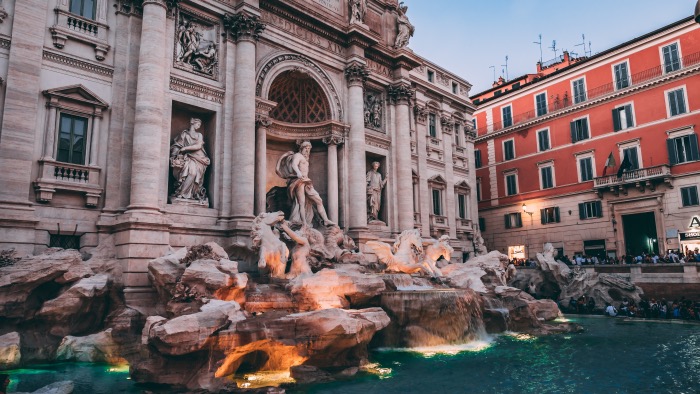
HISTORY AND CURIOSITIES ABOUT THE TREVI FOUNTAIN: A MAGICAL PLACE IN ROME
The Trevi Fountain is one of Rome’s most famous and iconic fountains, located in the Trevi district. The fountain was built in 1762 by order of Pope Clement XIII and is considered an example of Roman Baroque.
The Trevi Fountain has been restored several times throughout its history, most recently in 2014, and is one of the most important symbols of Rome.

Legend has it that anyone who throws a coin into the fountain and, turning around immediately afterwards, can see the coin disappear into the water, is guaranteed a return to Rome. If, on the other hand, he throws two coins he is guaranteed a return and even marriage, while with three coins he will return to Rome, get married and see a wish come true.
This tradition has made the fountain a very popular place for tourists and, for example, if you tour the city on the hop-on hop-off tourist bus in Rome, the Trevi Fountain is a stop that is never missed. In fact, you can get off the bus to admire the fountain and to throw a coin as a wish for good luck.
The Trevi Fountain also has historical value, as it was an important water source for ancient Rome, which was fed by the Acqua Vergine, a Roman aqueduct dating back to 19 BC.
WHO MADE THE TREVI FOUNTAIN
The design of the Trevi Fountain was commissioned by Pope Clement XII in 1730 and entrusted to the famous architect Nicola Salvi. The original design envisaged a large and elaborate fountain that would be the symbol of the city of Rome.
The fountain was designed in the Baroque style, with an imposing central sculpture representing Neptune being dragged by sea horses. The Trevi Fountain is surrounded by three niches containing statues of mythological goddesses: Abundance, Health and Wealth.
The original design also included a channelling system for the water that would have been fed from a thermal spring located a few hundred metres away. The water would have been piped into a series of canals and fountains, creating a unique hydraulic system.
However, the original design underwent several changes during its construction.
The Trevi fountain quickly became one of the symbols of Rome and is still one of the most important fountains in Rome and one of the most famous in the world.
This is why it is a must for all tourists visiting Rome who want to admire it and throw coins into the fountain to ensure their return to Rome.
This tradition of throwing coins has made it one of the richest fountains in the world, with an amount of money collected every day being donated to the poor.

CURIOSITIES ABOUT THE TREVI FOUNTAIN
- It is thought that the Trevi Fountain is so called because it is located at the end of three streets (‘trivio’, i.e. the intersection of the three roads): the Collatina, the Prenestina and the Tiburtina.
- Every day, around 3,000 euro coins are thrown into the fountain, which is used to finance various charitable initiatives in Rome.
- Besides the traditional throwing of coins, there is another tradition linked to the Trevi Fountain that has to do with a glass.
When young men once had to leave for work or military service, their girlfriends would make them drink water from the Trevi fountain from a new glass. The glass was then broken as a symbol of the pact of fidelity.
Today there is another version of this tradition whereby lovers drink together from the Fontanina degli innamorati, which is located to the right of the Trevi Fountain. In this they pledge allegiance to each other. - In 1960, Federico Fellini’s film ‘La Dolce Vita’ made the Trevi Fountain famous for Anita Ekberg and Marcello Mastroianni’s famous bath, one of the most famous scenes of 20th century cinema.
VISITING THE TREVI FOUNTAIN
One of the best ways to visit the Trevi Fountain is to walk to Piazza Trevi in Rome. You can get there by metro to the SAN CLAUDIO stop and then walk 50 metres.
However, you can hop on a hop-on hop-off tourist bus in Rome, the ones that allow you to get around Rome easily and stop in the immediate vicinity of the Trevi Fountain to flip the famous coin.

